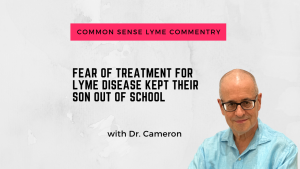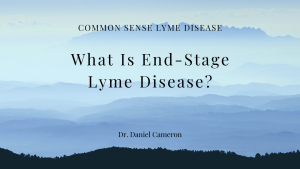
Tick Bite Treatment Options: What to Know and When to Treat
If you’ve been bitten by a tick, one of the first questions that comes up is: What should I do now?
There are different tick bite treatment options, and in my practice, I walk patients through two main approaches: watchful waiting or 3–4 weeks of antibiotics. Each has benefits and limitations, and the right choice often depends on the individual situation.
But first, let’s talk about a commonly recommended alternative that I do not advise.
Why I Don’t Recommend a Single Dose of Doxycycline
Some guidelines suggest a single 200 mg dose of doxycycline after a tick bite. While it may slightly reduce the chance of developing the erythema migrans rash, it has not been proven to prevent:
-
-
Neurologic Lyme
-
Lyme arthritis
-
Lyme carditis
-
Co-infections like Babesia or Anaplasma
-
I’ve seen several patients who received the single dose and later developed more serious symptoms. In my experience, it creates a false sense of security—and delays more effective treatment.
This is why it’s not part of the tick bite treatment options I offer.
Tick Bite Treatment Option 1: Watchful Waiting
One valid approach is watchful waiting. That means we don’t start antibiotics immediately but take a careful, structured approach:
-
-
Monitor for symptoms like fatigue, brain fog, rash, or joint pain
-
Schedule a follow-up appointment within 2–4 weeks
-
Consider lab testing for Lyme disease and co-infections
-
Watchful waiting may be appropriate when:
-
-
The tick was removed promptly
-
It wasn’t engorged
-
No symptoms are present
-
The patient prefers to avoid antibiotics unless needed
-
But there is a risk: If symptoms are missed or delayed, the infection can spread before it’s treated.
Tick Bite Treatment Option 2: 3–4 Weeks of Antibiotics
Another option is to begin treatment immediately—usually a 3–4 week course of doxycycline or a similar antibiotic.
This option may be preferable when:
-
-
The patient has a history of Lyme disease
-
The tick was engorged or attached for a prolonged period
-
Symptoms begin to appear soon after the bite
-
The patient prefers a more proactive approach
-
For patients who’ve experienced the consequences of delayed Lyme diagnosis, this is often the more reassuring path.
How I Help Patients Choose Between Tick Bite Treatment Options
Choosing the right path involves clinical judgment and patient input. I look at:
-
-
The type of tick and how long it was attached
-
Whether it was engorged
-
The presence of early symptoms
-
The patient’s medical history and level of concern
-
This is where shared decision making comes in. I provide the facts, listen to the patient’s priorities, and we decide together. That’s the heart of offering thoughtful tick bite treatment options.
What Tests Do I Use?
In some cases, I order lab tests to guide the decision. These may include:
-
-
A Lyme screening test such as ELISA, VlsE, or C6 peptide
-
Western blot to look for specific Lyme antibodies
-
Antibodies to co-infections like Babesia, Anaplasma, Ehrlichia, and Bartonella
-
However, I always explain that:
-
-
Early tests can be falsely negative
-
Co-infections may be missed
-
A clinical diagnosis is often still necessary
-
That’s why testing supports—but never replaces—clinical judgment.
What If the Patient Has Had Lyme Before?
Patients who have previously had Lyme disease often prefer early treatment.
They may have:
-
- Been misdiagnosed or treated late
- Suffered chronic fatigue, joint pain, or brain fog
- Been told their symptoms were unrelated or psychosomatic
These experiences shape how they evaluate tick bite treatment options—and often lead them to choose early antibiotics to avoid repeating the past.
Why I Always Recommend a Follow-Up Visit
No matter which treatment option we choose, I always schedule a follow-up.
This allows us to:
-
-
Reassess for new or worsening symptoms
-
Review lab results
-
Adjust treatment if needed
-
Lyme and other tick-borne illnesses don’t always show up right away, so this step is critical.
Final Thoughts on Tick Bite Treatment Options
There’s no one-size-fits-all approach to tick bites. That’s why I take time to present clear tick bite treatment options, explain risks and benefits, and engage my patients in shared decision making.
Whether we choose to monitor or treat immediately, the goal is the same: to catch any infection early and avoid long-term complications.
Call to Action
If you’ve had a recent tick bite and aren’t sure what to do next, I encourage you to reach out to your doctor.
Together, you can review your tick bite treatment options and make the decision that best fits your risk level and health goals.
-
Shared Decision Making in Lyme Disease
https://danielcameronmd.com/shared-decision-making-lyme-disease/ -
Infectious Diseases Society of America – Lyme Disease Guidelines
https://www.idsociety.org/practice-guideline/lyme-disease/ -
CDC – Lyme Disease: Diagnosis and Testing
https://www.cdc.gov/lyme/diagnosistesting/index.html



I contacted Lyme in late 1988. Was not treated until July 1990 when I finally found a Dr who would listen to me. Dr Joseph immediately started me on IV antibiotics on and off for 18 months. Shortly after I started seeing an infectious disease Dr in Reading, PA who consulted with a neurologist finding my headaches and failing eyesight was caused by increased spinal pressure. He again started me on high doses of IV antibiotics. After 16 weeks all the neurological and other physical symptoms were gone. I do support your theory that the infection can be persistent for years.
I got an insect bite a couple days ago. first I thought it was a spider bite but as I look at pictures of tick bites i think it may have been a tick. I got the red circle and then a white blister the size of a pencil eraser. It busted but the red is still stere after 10 days. Should I be tested for lyme disease? fe*********@***il.com
The CDC grants that an erythema migrans rash should be at least 2 inches in diameter. I advise my patients to evaluate every bite.
I own a rural property and I’m frequently exposed to ticks.
I was tested by my gp several years ago after complaining about severe fatigue and joint pain. Test came back and was what my doc determined to be a false positive. no treatment.
I just again found a tick latched on 5 days ago. have had severe fatigue and joint stiffness. Should I be tested again?
I am always concerned with patients with severe fatigue and joint pain whose tests are dismissed as false positive. I reevaluate my patients again after a tick bite.
I would want at least two weeks of doxycycline after any tick bite
My wife is now waiting for test results Both she and a few other people in the medical family around here are just waiting to see how fast she will get back results
we know she is positive se how they handle it.
I hope the tests come through for your wife
I had a tick on my ear for likely a week or more as my ear was sore that long. I thought I had pulled on the earring but when I finally removed the earring an engorged tick was under it. I am in Ontario and the only testing is private. I sent the tick to geneticks who confirmed it was an engorged female blacklegged tick that is positive for Lyme and a couple other illnesses. My dr thinks I should wait and see if I get ill but I think treating faster is best. 2 1/2 weeks after the tick was removed my ear is still very swollen. Advise please
The longer the tick is attached the more likely it will transmit Lyme disease. Your tick was engorged. I take that into consideration
my son has about six large red circle sores with dark centers that are very itchy…in groin, armpits. he and his dog must be
checked all over every time they go out on his wooded property. his wife removed ticks with tweezers but they don’t know if they got the head.
I advise my patients to include a Lyme disease evaluation while being assessed for other illnesses.
I advise my patients to be evaluated for unexplained circles particularly if they are over 2 inches in diameter